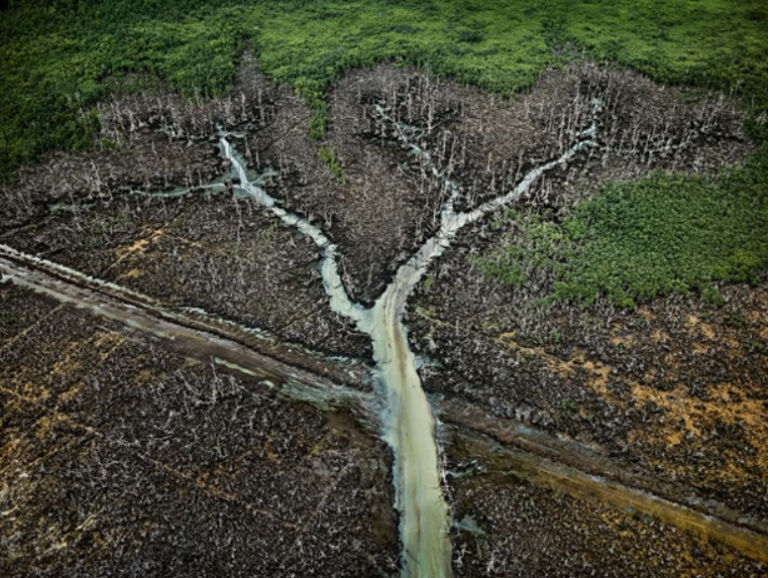Summary

- Photographer: Edward Burtynsky (born 1955)
- Title and Date: Oil Bunkering #2, Niger Delta, Nigeria, 2016
- Medium/Scale: Digital image, chromogenic print, size 99.1 × 132.1 cm
- Collection: Part of the Anthropocene project (2016). Rights belong to the author.
Brief Description
Oil Bunkering #2 is a digital image shot by Canadian artist Edward Burtynsky, known for his pro-active environmental position (Figure 1). The copy that belongs to the Metropolitan Museum of Art was printed using chromogenic print (C-print). In other words, it is written on photo paper with the help of Chromira or a similar digital writer. It shows the part of the high-density Niger Delta region that is contaminated with oil and its by-products. Although the image is beautiful, it still makes people wonder how they impact the planet.
Medium
Burtynsky is also known for his large-format landscape photographs, and this one is not an exception. The colored aerial image was taken with the help of a chopper, drone, or airplane allegedly using a 60 megapixel Hasselblad (Weingart, 2017). The author prefers it due to the softer color negative that makes photos look less commercial. The images shot for the documentary also involved the Red Epic Dragon camera (Filmmaker Staff, 2019). During the project, Burtynsky often worked with an 8×10 format to capture the whole scene in a single frame.
The lenses involved are wide-angle ones; the shutter speed should be between a second and three seconds. The aperture seems to be not so high, as the depth of field is quite deep. Burtynsky did not use any additional light in the daylight. To make this large-scale image, the artist had to wait for adequate light (Buder, 2019). The Canadian photographer uses Imacon embedded software in the camera and the computer for color management (Weingart, 2017). Oil Bunkering #2 has soft and warm colors that are elements of the artist’s own style. For the Metropolitan Museum of Art, the image was printed in 99.1×132.1 cm and put into a black 104.8×137.2 cm frame.
Content and Context
The large-scale image shows the part of the river in the Niger Delta polluted with oil. It is an effect of the process called “bunkering” when poor locals siphon off oil from the pipelines and process it in their micro-refineries (The Metropolitan Museum of Art, 2016). It leads to ongoing pollution of land, air, and delta waters, causing devastating effects on residents’ livelihood and health (Ratcliffe, 2019). This photograph is balancing between pure reporting and conceptual work that raises symbols and essential ecological issues. For instance, the bifurcated river from above resembles a tree hit with destructive black material. Oil Bunkering #2 provokes mixed feelings regarding the association between human activity and nature exploitation.
This image can be fully understood only as a part of a series called the Anthropocene. The scenes here are organized by subjects, including mines, quarries, water, and oil, showing the marks people left on the Earth’s surface. The majority of presented pictures put spectators in a tension between the reality of the environmental devastation they show and how beautiful they are (Ahmed, 2018). The author aims to reflect on the relationship between human activity and its consequences, increasing individuals’ awareness and responsibility.
The work has been a part of a museum exhibition that premiered in Canada in 2018. The National Gallery of Canada and the Art Gallery of Ontario simultaneously presented new conceptual photographs of Edward Burtynsky. The exhibition continued to tour the world, including such destinations as Italy and other European states in 2019. In general, the project is multidimensional, involving photographic prints, film, and AR installations. As mentioned earlier, this photo is added to the collection of the Metropolitan Museum of Art, New York.
Larger Context
The work of Edward Burtynsky is an excellent example of conceptual landscape photography. He tries to balance between making beautiful shots and depicting the devastating effects of humankind on nature. The Canadian and his colleagues worldwide contribute to contemporary environmental geographies, highlighting the issues hidden from our eyes. Photographic projects such as American Documerica proved useful for environmental studies (Buckley and Youngs, 2018). The environmental representation in the photographic record both provides crucial information for research and provokes critical thinking among museum visitors and Internet users.
The artist’s work and style area encourage me to be focused on the concept and meaning behind the shot rather than just the correct angle or beautiful scenery. It brings me the idea to try something similar in local realities to draw the community’s attention to the environmental problems that need joint action. What is more, Burtynsky’s experience working with drones in all continents except Antarctica shows its potential and usefulness for such tasks.
Reference List
Ahmed, F. (2018) ‘It’s hard at this particular moment to be optimistic’ – Edward Burtynsky on the future of the planet‘, Apollo Magazine. Web.
Buckley, G. and Youngs, Y. (2018) The American environment revisited: Environmental historical geographies of the United States. Lanham: Rowman & Littlefield.
Buder, E. (2019) ‘29 cameras and 203 hours of footage later, this haunting movie exists‘, No Film School. Web.
Filmmaker Staff (2019) ‘Filming in 44 locations in 22 countries on six continents’: DP Nicholas de Pencier on Anthropocene: The Human Epoch‘, Filmmaker. Web.
Ratcliffe, R. (2019) ‘This place used to be green’: the brutal impact of oil in the Niger Delta‘, The Guardian. Web.
The Metropolitan Museum of Art (2016) Oil Bunkering #2, Niger Delta, Nigeria. Web.
Weingart, K. (2017) ‘An interview with Edward Burtynsky’, PetaPixel. Web.